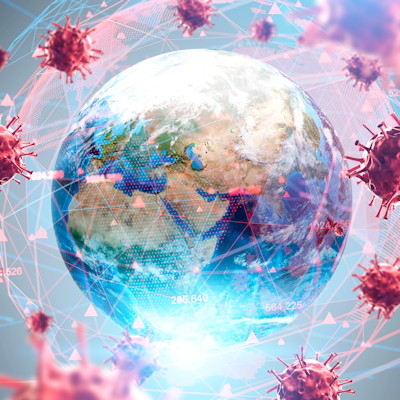April 22, 2020 -- A new study pinpoints the most likely cell types that SARS-CoV-2 infects. Unexpectedly, the study indicates that one of the body's main defenses against viral infections may actually help the virus infect susceptible cells. The findings were published on April 21 in Cell.
Researchers have meticulously elucidated many facts about how SARS-CoV-2 -- the causative RNA virus of the COVID-19 respiratory disease -- infects cells, including that the virus uses human host factor angiotensin-converting enzyme 2 (ACE2) as a receptor. The SARS-CoV-2 spike (S) protein binds with ACEs and the main host protease -- type II transmembrane serine protease (TMPRSS2) -- mediates S-protein activation on primary target cells and initial viral entry. Yet the specific cell subsets within each tissue that express ACE2 remain unknown.
After viral entry into a host cell, interferon (IFN) induces interferon-stimulated genes (ISGs) to mount host antiviral defenses. Some evidence has indicated that all three types of IFNs -- Type I IFNs (IFNα, IFNβ), Type II IFNs (IFNγ), and Type III IFNs (IFNλ) -- may not equally represent the full immune-protective response in primary human target cells.
Based on this knowledge, researchers from Boston Children's Hospital and MIT wanted to answer several questions: What does SARS-COV-2 do in the body? Why are some people more susceptible?
SARS-CoV-2-susceptible cells
To understand viral pathogenesis, the researchers wanted to identify the cell types targeted by SARS-CoV-2 and those at highest risk of direct infection (based on expression of ACE2 and TMPRSS2). They analyzed new and existing single-cell RNA sequencing (scRNA-seq) datasets from nonhuman primates and humans to assess which cell types express ACE2 along with TMPRSS2.
Coexpression of ACE2 and TMPRSS2 was detected at low rates in only a specific subset of cell types consisting of type II pneumocytes in the lung, absorptive enterocytes within the gut, and goblet secretory cells of the nasal mucosa.
"Many existing respiratory cell lines may not contain the full mix of cell types, and may miss the types that are relevant," said senior author Jose Ordovas-Montanes, PhD, researcher at Boston Children's Hospital, in a statement. "Once you understand which cells are infected, you can start to ask, 'How do these cells work?' 'Is there anything within these cells that is critical for the virus's life cycle?' With more refined cellular models, we can perform better screens to find what existing drugs target that biology, providing a stepping-stone to go into mice or nonhuman primates."
Interferons in SARS-CoV-2 infection
From the analysis of the scRNA-seq datasets, the researchers identified several associations between ACE2 expression and components of the IFN-signaling pathway. According to the researchers, IFNs may permissively allow tissue-protective host responses or increase viral binding to SARS-CoV-2.
To explore what role interferons play in regulating ACE2 expression levels in target cells, they tested whether IFNα, a Type I IFN, upregulated ACE2 expression in primary human upper airway epithelial cells and goblet cells.
They discovered that Type I IFNs, and to a lesser extent Type II IFNs, upregulated ACE2 expression in respiratory cells. This suggests that IFN could promote the ability of SARS-CoV-2 to maintain cellular targets and infect neighboring human upper airway epithelial cells.
"ACE2 is also critical in protecting people during various types of lung injury," noted Ordovas-Montanes. "When ACE2 comes up, that's usually a productive response. But since the virus uses ACE2 as a target, we speculate that it might be exploiting that normal protective response."
Because ACE2 is primarily upregulated in epithelial cells, it may have been unappreciated as a canonical interferon-stimulated gene (ISG) that is traditionally found within immune cell populations. The authors note that ACE2 was identified as an ISG in human upper airway epithelial basal cells, but not in mouse airway epithelial basal cells or pulmonary epithelial cells. Due to the varying effects of the IFN system in ACE2 expression in tissues and cell type-dependent ways, SARS-CoV-2 may impact the same cell types within various tissues uniquely.
"It might be that in some patients, because of the timing or the dose, interferon can contain the virus, while in others, interferon promotes more infection," explained Ordovas-Montanes. "We want to better understand where the balance lies, and how we can maintain a productive antiviral response without producing more target cells for the virus to infect."
In the future, the team wants to explore what the virus is doing in the cells it targets and to study tissue samples from children and adults to understand why COVID-19 is typically less severe in younger people.
Do you have a unique perspective on your research related to immunology or virology? Contact the editor today to learn more.
Copyright © 2020 scienceboard.net







